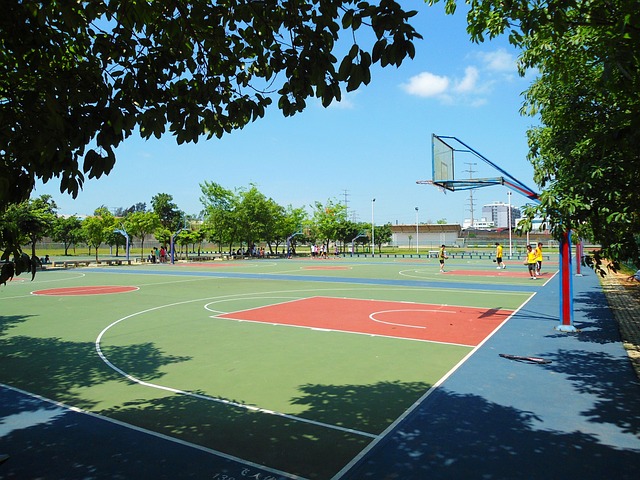Want to be like Steph Curry pulling up from over twenty-five feet away from the three-point line and effortlessly swishing the ball in the basket? Or how about taking off from the free-throw line to dunk like Mike? Basketball court dimensions are inherent knowledge to the best players of the game and you should know them all.
Key Measurements
Key measurements for basketball court dimensions are standardized to ensure consistency in the game. Here are the crucial measurements:
- Overall Dimensions: The standard length of a basketball court is 94 feet (approximately 28.65 meters), and the width is 50 feet (about 15.24 meters).
- Free-Throw Line: The free-throw line is positioned 15 feet (around 4.57 meters) horizontally from the backboard.
- Three-Point Line: The three-point line is a semi-circle with a radius of 23 feet 9 inches (approximately 7.24 meters) from the center of the basket in both NBA and FIBA regulations.
- Key or Paint Area: The key, also known as the paint area, is a rectangular shape measuring 16 feet (4.88 meters) in width along the baseline and extending 19 feet (5.8 meters) from the baseline towards the free-throw line.
- Basket Height: The height of the basket rim is standardized at 10 feet (3.05 meters) above the playing surface.
- Backboard Dimensions: The backboard has a width of 6 feet (1.83 meters) and a height of 3.5 feet (1.07 meters).
- Center Circle: The center circle, used for the jump ball at the beginning of the game, has a diameter of 6 feet (1.83 meters).
Court Lines and Markings
Understanding the various components of a basketball court provides a comprehensive view. It’s important to note that measurements may vary based on the level of play at your gym’s basketball court.
The Lane, situated at the front, is a 16-foot area running from the front-court baseline to the foul line. The Three-point arc forms a semi-circle at a distance of 23 ft 9 in from the center of the basket. Sidelines and Baselines, each measuring 94 feet, define the length of the court.
The Center circle, five feet in diameter and centered on the midcourt line, plays a significant role. The Key area, shaped like a coin, measures 12 feet long by 19 feet wide and encompasses the foul line, basket, backboard, and other court markings. The Division line, situated in the middle, evenly splits the court into two parts.
While smaller elements like hash marks, the restricted area under the hoop, and the basket and backboard exist, the aforementioned components constitute the primary spatial requirements for a new court.
Three-Point Line Distance
As stated before, if you want to shoot like Curry, then you need to know this distance better than the back of your hand. In major professional leagues like the NBA (National Basketball Association) and international play under FIBA (International Basketball Federation), the three-point line is set at a distance of 22 feet (approximately 6.7 meters) to 23 feet 9 inches (about 7.24 meters) from the center of the basket. However, in some youth or amateur leagues, the three-point line may be closer, adhering to different standards or regulations established for those levels of play.
Free-Throw Line and Circle
To avoid the pitfalls of centers like Shaq who stood at this line not knowing how to make it in the basket, this will be an important distance because it’s the most common spot that shots are taken.
The free-throw line is a horizontal line located 15 feet (4.57 meters) away from the backboard. When a player attempts a free throw, they stand on this line. Around the free-throw line, there is a circle with a 6-foot (1.83 meters) radius. This circle is often referred to as the free-throw circle or key. Players attempting free throws must release the ball from within this circle.
These dimensions are consistent in both professional and amateur basketball, ensuring uniformity in the free-throw shooting area across different levels of play. The free-throw line and circle play a crucial role in free-throw attempts, serving as a designated area for players during these shots.
Backboard and Rim Specifications
To achieve the status of dunk champion, a very specific size and surface area is required for you to know. The width of a standard backboard is 6 feet (1.83 meters) and the height of a standard backboard is 3.5 feet (1.07 meters).
The rim is positioned 10 feet (3.05 meters) above the playing surface. This height is consistent across all levels of play and is a fundamental aspect of the game. The rim itself has a standard diameter of 18 inches (45.72 centimeters). This measurement applies to the metal ring through which the basketball must pass during scoring attempts.
Half-Court Dimensions
Ever been selected during the halftime half-court challenge to shoot and win a prize? After reading this and practicing, you could be in a better position to win. The length of a half-court is 47 feet (about 14.33 meters). This measurement is calculated by halving the full court length of 94 feet. The width of a half-court is 50 feet (approximately 15.24 meters). This dimension remains the same as the full court.
FAQs
What are the standard dimensions of a basketball court?
The length of the court is set at 94 feet, measured from baseline to baseline. The width of the court is 50 feet, measured from sideline to sideline. These dimensions apply to professional basketball leagues and international competitions.
How far is the three-point line from the basket?
In both FIBA and NBA regulations, the three-point line is set at a distance of 22 feet from the basket along the arc.
Are there different court sizes for high school and professional basketball?
The length of a standard high school basketball court is 84 feet, which is 10 feet shorter than a professional court. The width remains the same at 50 feet. These variations in court size are in line with the different rules and regulations established for high school basketball.
